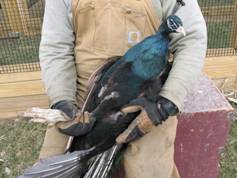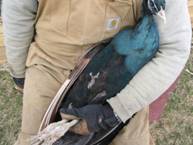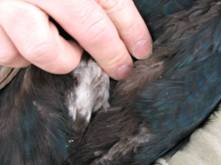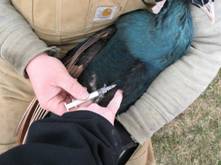Back to Peafowl Articles
Intramuscular Medication Dosing of Peafowl
Hopkins' Alternative Livestock does not accept any responsibility for the
use of this information by others than Hopkins' Alternative Livestock.
Craig Hopkins
Many peafowl medications are most effective when given intra-muscular. An intra-muscular dose of medication assures that the peafowl are getting the proper dose and that no bird has missed getting the medication. When peafowl are showing signs of illness, there is no better way to get them on the road to recovery than to give them the medication directly in to their breast muscle. While intra-muscular dosing has many advantages, it must be done properly to assure that the bird gets the full benefit of the medication and is not injured during the process. The purpose of this article is to describe and illustrate the proper method of giving an intra-muscular dose of medication to peafowl. The steps described in this article can be done by one or two people.
 The
first step in this process is to catch the peafowl and to properly restrain them
so that they donít injure themselves or you.
I use a large fishing net with a long retractable handle to catch the
bird. The net material is not the
normal coarsely woven nylon mesh. I
use a tightly woven nylon mesh made especially for catching birds.
Entire nets or just the mesh material can be purchased from most poultry
or pheasant supply companies. Once
the bird is caught, pin the bird to the ground with the net and grasp both legs
firmly with a gloved hand. It is
best to grasp both legs at the knee joint and to hold both legs in one hand.
Remove the bird from the net and cradle it against your body so that it
canít flap its wings.
The
first step in this process is to catch the peafowl and to properly restrain them
so that they donít injure themselves or you.
I use a large fishing net with a long retractable handle to catch the
bird. The net material is not the
normal coarsely woven nylon mesh. I
use a tightly woven nylon mesh made especially for catching birds.
Entire nets or just the mesh material can be purchased from most poultry
or pheasant supply companies. Once
the bird is caught, pin the bird to the ground with the net and grasp both legs
firmly with a gloved hand. It is
best to grasp both legs at the knee joint and to hold both legs in one hand.
Remove the bird from the net and cradle it against your body so that it
canít flap its wings.
 The
second step is to hold the bird in such a way to allow for the injection to be
given in the breast muscle. If two
people are participating, hold the bird on its back in your lap.
Continue to hold the legs at the knee joint and secure the wings against
your body and with your free hand. If
you are working by yourself, hold the bird on its back in your lap.
Hold the feet at the knee and secure the wings with your hand and arm.
Your free hand will be needed to administer the injection.
I am right handed so reverse the birdís position if you are left
handed.
The
second step is to hold the bird in such a way to allow for the injection to be
given in the breast muscle. If two
people are participating, hold the bird on its back in your lap.
Continue to hold the legs at the knee joint and secure the wings against
your body and with your free hand. If
you are working by yourself, hold the bird on its back in your lap.
Hold the feet at the knee and secure the wings with your hand and arm.
Your free hand will be needed to administer the injection.
I am right handed so reverse the birdís position if you are left
handed.
 The
next step is to locate the breast muscle. This
can be done by running your fingers along the breast bone and then feeling on
either side of the breast bone. In a
healthy bird, the breast bone will feel dull to the touch and the muscle will be
nice and firm. In a sick bird, the
breast muscle will feel very sharp and the muscle will be very small and hard to
distinguish. Be careful in this
scenario not to hit the bone with the needle and possibly break it off.
Once the breast muscle has been found, insert the needle at a 45 degree
angle to the muscle and inject the medication.
If repeated injections are required to cure the bird, it is a good idea
to alternate the injections on both sides of the breast bone.
The
next step is to locate the breast muscle. This
can be done by running your fingers along the breast bone and then feeling on
either side of the breast bone. In a
healthy bird, the breast bone will feel dull to the touch and the muscle will be
nice and firm. In a sick bird, the
breast muscle will feel very sharp and the muscle will be very small and hard to
distinguish. Be careful in this
scenario not to hit the bone with the needle and possibly break it off.
Once the breast muscle has been found, insert the needle at a 45 degree
angle to the muscle and inject the medication.
If repeated injections are required to cure the bird, it is a good idea
to alternate the injections on both sides of the breast bone.
 I
use 3cc syringes with 20 gage needles to dose most medications.
The needles are ĺĒ in length. This
length of needle helps to prevent going to deep with the needle and penetrating
through the muscle. An insulin
syringe works well for small doses and on young peafowl.
Once the proper syringe has been selected and the proper dose of
medication has been drawn in to the syringe, you are ready to medicate your
bird. Once the syringe is empty,
remove it from the birdís breast and apply light pressure where the shot has
been placed for 15 seconds. The bird
can now be released.
I
use 3cc syringes with 20 gage needles to dose most medications.
The needles are ĺĒ in length. This
length of needle helps to prevent going to deep with the needle and penetrating
through the muscle. An insulin
syringe works well for small doses and on young peafowl.
Once the proper syringe has been selected and the proper dose of
medication has been drawn in to the syringe, you are ready to medicate your
bird. Once the syringe is empty,
remove it from the birdís breast and apply light pressure where the shot has
been placed for 15 seconds. The bird
can now be released.
I hope that you have found this article informative and helpful. Intra-muscular dosing of medications is a very effective method and when done properly, completely safe for the birds and for you.
Back to Peafowl Articles
© 2010, Hopkins' Alternative Livestock
Web site designed and maintained by Lisa Hopkins